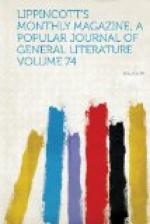Shrinking
Caryatides
Of just-tinged marble, like Eve’s
lilied flesh.
This weird love-ballad in prose must have taxed the translator almost as much as if it had been in rhyme; for although an interpreter of poetry undeniably has the difficulties of form to struggle with, yet there is, on the other hand, an inspiration and waft of feeling in the metre which lends him wings and helps him on. If Mr. Stern does not encumber his style with a betrayal of the difficulties he has got over—if he does not give us pedantry and double-epithets, so common in vulgar renderings from the German—he certainly shows no timidity in turning the polished familiarity of Heine’s prose into our commonest vernacular. “What lots of pleasure I found on my arrival;” “for the men, lots of patience:” trivialities of expression like these are not rare in his version. If they are not quite what Heine would have written if he had been writing in English, at least the fault of familiarity is better than the fault of hardness; and these translations are never at all hard or uncomfortable. When we add that Mr. Stern gives us an index without showing what works the extracts are taken from, and that he gives us an article on Heine without any mention that we can discover of Heine’s wife, we have vented about all the objections we can make to this welcome publication; and they are very few to find in a collection of hundreds of “scintillations.”
The pleasures that remain for the reader are manifold: so liberally and judiciously are the extracts chosen that we get a complete exhibit of Heine’s mind on nearly all the topics he occupied himself about. We have his views on French and German politicians; on French, German and English authors; on art and poetry; on his own soul and character; on religion; besides a great deal of that persiflage, the most exquisite persiflage surely that ever was heard, which flutters clear away from the regions of sense and information, yet which only a man of sense and information could have uttered.
Heine came to Paris in 1831, and saw all the sights and found everything “charming.” His wit is a little cheap, perhaps, when he calls the Senate Chamber at the Luxembourg “the necropolis in which the mummies of perjury are embalmed;” at least it becomes tiresome to hear his constant disparagement of the politics which he chose to live under, and which protected him so agreeably; but he is his own keen self where he observes that the signs of the revolution of 1830, what he calls the legend of liberte, egalite, fraternite at the street-corners, had “already been wiped away.” Victor Hugo, for his part, did not find it so: he says that the years 1831 and 1832 have, in relation to the revolution of July, the aspect of two mountains, where you can distinguish precipices, and that they embody “la grandeur revolutionnaire.” The cooler spectator from Hamburg inspects at Paris “the giraffe, the three-legged goat, the kangaroos,”




